25 Jan 2023
Can better representation reduce waste for online fashion retailers?
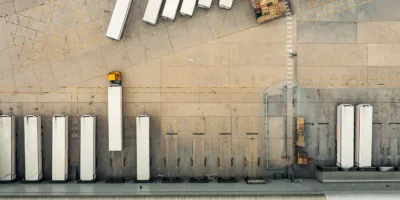
How do you reduce waste from returns and help customers to buy the right product first time? Steve talks us through his learnings from research with online fashion retailers.
-
Steve Cable
Experience Director
Steve Cable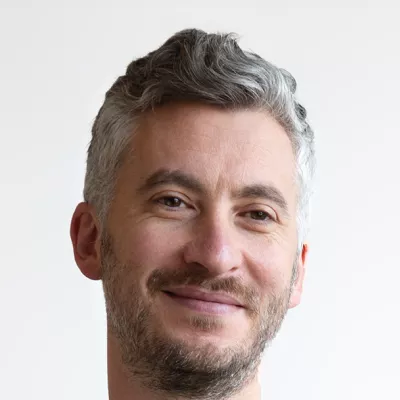
In 2022 I carried out a lot of user research for many online fashion retailers. There were two big themes that these brands were interested in learning about. One was, how do we reduce the waste caused by a high level of returns? The other was around making customers more aware they sold a broad range of sizes. It became apparent fairly early on that these two issues and the solution to them were linked.
The returns issue
Consumers are used to free delivery and free no quibble returns. They can order a bunch of items, try them on and send back what they don’t like. Sounds great in theory, but it’s costing retailers money, wasting energy by transporting products back and forth and wasting products that don’t get re-sold after they are returned. It’s obvious why retailers want to change this buy-try-return behaviour, but it’s not easy.
You are never going to be able to remove all product returns in the fashion industry, but you should be able to reduce them by making people more confident in their purchases. The hypothesis is; if you can make people feel confident that a garment is right for them, then they won’t need to buy any backup items and won’t return the item they chose because it will be exactly what they expected.
Building confidence in purchase decisions
Making sure people are confident in what they are buying, and buying the correct sized item first time is tricky, especially when it comes to clothes. It’s not just the challenge of getting the right size, but how is it going to sit on your body? What is the fit? How does the material feel? How does this colour look against my skin? Customers may technically order the right size, but if it doesn’t feel right, they are going to send it back.
This is super challenging when you can’t see or touch the product before you commit to buying it. So how do we give people an accurate representation of a garment online?
The brands we worked for all came to us to test different pieces of technology to solve this problem. It became clear fairly quickly, however, that this wasn’t a technology problem. It was a content problem.
Tech solutions don’t quite solve the problem
The technological solutions to the size and fit problem all essentially involve gathering data from the user about their body and preferences, whether through forms that customers need to fill out or through image scanning and AI. They then use algorithms to recommend the right product. These seem like great solutions on the surface, but there were common problems that we saw across all of them.
Disruption to the shopping experience
For the people we interviewed, fit finders that ask lots of questions across multiple screens can feel like a tedious interruption to what should be an enjoyable clothes shopping experience. This problem is exacerbated by the fact that almost every fashion retail site has some sort of fit finder. So are you supposed to re-enter your details every time?
The image and body scanning solutions are trying to speed up this process for people. But they come with their own issues.

Making people feel bad about themselves
Most people feel self-conscious about their bodies, and if you aren’t careful, your goal of finding people the right fitting product can end up creating an uncomfortable experience for customers. At the extreme end of the scale, there are tools and apps that work by scanning people’s bodies, asking them to strip down to their underwear and take a series of photos of themselves. People were understandably not comfortable doing this and were worried about what would happen to all the images of them in their pants that the tool was capturing.
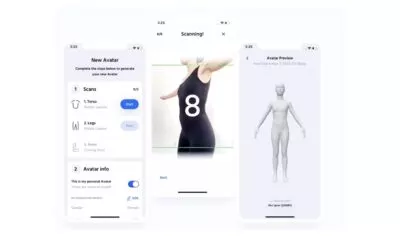
And it doesn’t even have to be that extreme to make people feel bad about themselves. Just having a form that asks people about their weight and body shape is enough to make some people uncomfortable and unwilling to use fit-finding tools.
Reliant on data
Tools that ask you for your height, weight, chest size, arm length etc, rely on the fact that this is data that people know off the top of their heads. The questions in size and fit tools that we observed being easier to answer were those about the brands and sizes of clothes they had previously bought. This information was much easier for people to recall.
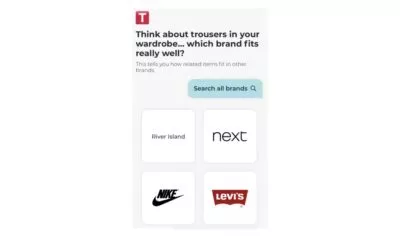
Finding the right clothes isn’t just about data. Just because your measurements make you a medium doesn’t necessarily mean you want to wear a medium. What if you wanted a looser fit? How does the fabric feel? What’s the weight of it? How does it sit on your body? These are things algorithms can’t answer quite yet.
How representation can help
Across all the user testing sessions we did in 2022, the most effective way to help people understand what size of clothing they should buy and whether it would look good on them was to show how it looks on someone that looks like them.
When user testing various fashion retail sites, we consistently saw people trying to figure out what size would be right for them by studying the product images, the size of the garment in the photo and the body shape of the model wearing it. You can make this easier by telling users what size item your model is wearing and size information about the model.
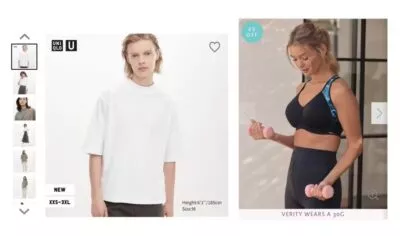
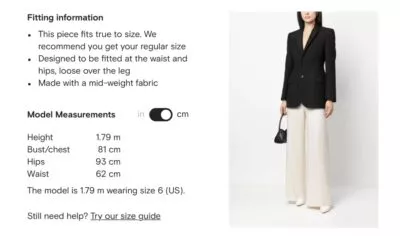
To make this even easier for customers, you need to have more than one model showing off each product. Sites with product pages that only have one model wearing the clothes, and that model was a slim person, made it increasingly harder to gauge what size to get. The more different a user looks from the model on the product page, the harder it is to imagine how it would look on them. This is why representation matters when shopping for clothes online.
The more diverse the range of models you have, the easier it will be for people to choose the right size, and the more confident they will be in their choice. This isn’t just about size, either. It’s about body shape vs the cut of the item and about skin tone vs the colour of the item. All of this helps people answer the question, ‘Will this look good on me?’

Very few online fashion retailers are using multiple models on their product pages. It was actually quite hard to find examples of brands that do this. This is probably because hiring more models and generating more product shots can be costly and time consuming. It does, however mean there’s an opportunity to differentiate your brand from competitors. It may also reduce the number of returns because customers are able to choose the right product and size. There is also a potentially more scalable way to get better representation of body types on your product pages…
Get content from real people
Lots of brands allow customers to share images of them wearing products. For example, Boden has Boden By Me, which shows customers’ instagram images. But these are really just for promoting the brand as a whole and not tied to specific products.
Amazon goes one step further and allows customers to upload images of their products as part of their reviews. This enables customers to see the product on real people with a range of body types and skin tones. Research participants also commented on how helpful it was to see the product in different lighting conditions. It’s great to see how a dress looks in a studio, but how will it look in a dimly lit Christmas party? Or outside during a summer wedding?

As well as seeing images of clothes in reviews, additional context about the reviewer was also really helpful to the people we interviewed during research. Understanding what size product they bought, how it fitted and what size they typically buy all helps determine what would feel right for them. Using a review engine that captures information about size and fit is going to be vital for fashion retailers going forward.

TLDR; So how can you help people buy the right fitting product?
If you want to reduce returns by preventing people from buying multiple sizes of the same product and ensuring they buy the right size first time, you need content that shows how the product looks on different body types and skin tones.
Specifically, you should:
- Add information about the model and the size they are wearing to product images
- Add as diverse a range of models for each product as possible
- Use a review engine that prompts people to comment on the fit of the product and provide information on the size they bought and their body type
- Encourage customers to share images of their product as part of reviews
- Focus the questions included in size and fit tools on what products people have bought before
- Avoid body scanners!
It’s been encouraging to see fashion brands looking to reduce waste and improve their representation. It’s even more encouraging to see that it has the potential to increase sales and reduce costs. Because let’s be honest, when brands make positive social and cultural changes, it’s not usually because it’s the right thing to do but because there is a tangible business benefit.



